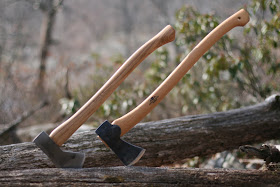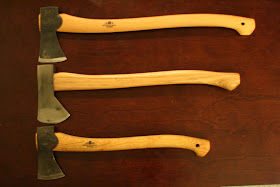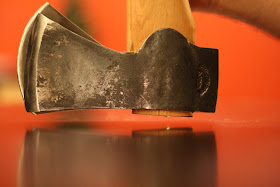
Specifications:
Manufacturer: Barco Industries
Axe Head Weight: 3.5 lb
Axe Length: 36 inches
Axe Head Material: Unknown carbon steel
Handle Material: Hickory
Cost: $84.00

First, for a bit of history. Production of axes under the Kelly name started in 1874. Around the end of the 19th century, the brand Kelly Perfect had come on the market. The brand quickly became famous, and contributed to the company becoming the largest axe manufacturer in the world. As a result of the Great Depression however, in 1930 the American Fork & Hoe Co. bought out Kelly, and in 1949 was purchased by the True Temper Corporation, resulting in the True Temper Kelly axes with which we are most familia today. Throughout this whole time the Kelly Perfect axes remained in production. In 1987, Barco Industries of Pennsylvania purchased the Kelly name from True Temper along with the patents and dies. They continue to make the Kelly Perfect and Kelly Woodslasher axes, although I hear they may be discontinuing the lines in the near future. The only patterns of the Kelly Perfect axe that are still in production are the full size Dayton and Michigan single bit ones.
I don’t have any good full size axe to which I can compare the Barco Kelly Perfect, but I will make some minor comparisons to the Kelly axes of the past. For those of you who are curious, you can buy the axes directly from Barco here.
The axe arrived in excellent condition. The overall fit and finish was great. I have become accustomed at looking at axes with production defects, but there did not appear to be any here. Everything was measured and shaped exactly right.


The handle is 36 inches in length, and has nearly perfect grain. It has been a long time since I have seen a full size handle that is such high quality.
The head weighs 3.5 lb, and is attached to the handle only with a wooden wedge. The shape of the head is as close to my ideal as I have been able to get from a production axe. The lines are smooth and continuous, with the bevels providing for reduced binding for the rare occasion you go that deep into the wood. There were no imperfections with respect to the head that I could notice.
When compared to a True Temper 3.5 lb Kelly Perfect head, there are some minor differences. The shape is sightly different, although the Perfect pattern was used on many different style heads. The balance of the Barco head is a bit better, resulting from a larger poll. The most noticeable difference is that the True Temper head has cheeks that thin out towards the top and bottom of the head, making it appear much thinner than the Barco head. In reality, the center of the two heads is the same thickness.
The balance of the axe is very good. The poll is a few ounces short of perfect, but it is hard to complain about this balance.
So, is this the perfect axe? Well, no. There are two things which keep me from telling everyone to buy it right now.
The first problem is that the axe I bought had a slightly loose head. That makes me very unhappy, especially considering how well finished the rest of the axe was. I tried removing the handle, but I only managed to slide the head up about a quarter of an inch, before it got stuck. Clearly the eye is tapered to prevent the head from slipping off. I solved the problem by just putting in a metal cross wedge. After that the head held securely during the testing.
The second, and what I consider a larger problem is that the bit of the axe is not finished. I have said with respect to many axes, that the bit has been left too thick for my liking. With this one however, it is just unfinished, and clearly intentionally so. Most axes will have a shiny portion of about half to one inch from the bit. That results from the axe being put to a grind stone to create the edge. The Barco Kelly Perfect axe however, has not been ground at all, and as such there is no edge. This is probably done because industrial customers will be happy to put the type of edge they want to see on the axes they buy. For the average user however, putting a good edge on the axe will require a good amount of work with the file.
It took me about an hour and a half of filing to put the type of edge I like. The pictures that you see in the review, except for the one immediately above, are of the sharpened axe. The metal was not the hardest I have ever worked with, but it was not the softest either. I don’t know if the unfinished edge is a traditional characteristic of the Kelly axes. The True Temper Kelly Perfect head that I used for the above comparison had also bees seriously worked. The edge shows filing marks going back almost an inch from the bit.
So, do I recommend this axe? Well, I only recommend it if you are willing to put an edge on it yourself. If you know what you like, and have the ability to do it, then I would strongly recommend this axe. The fit and finish is better than any I have seen on a production axe in a long time. If however, you are not willing to rework the edge, this is not the axe for you. Out of the box, it will be of absolutely no use. The performance of the axe will depend entirely on the type of edge you put on it.
As far as I know, the manufacturer produces additional bushcraft appropriate axes: The Michigan Pattern Single Bit Axe (3.5lb head; 36 inches in length); The Kelly Woodslasher Dayton Sigle Bit Axe (3.5lb head; 36 inches in length); The Kelly Woodslasher Dayton Sigle Bit Axe (4lb head; 36 inches in length); The Kelly Woodslasher Michigan Single Bit Axe (3.5lb head; 36 inches in length); The Kelly Woodslasher Michigan Double Bit Axe (3.5lb head; 36 inches in length); The Kelly Woodslasher Michigan Double Bit Cruiser Axe (2.5lb head; 36 inches in length); Kelly Woodslasher Wester Double Bit Axe (3.5lb head; 36 inches in length); The Boy's Axe (2.25lb head; 28 inches in length); The Hunter's Axe/Hatchet (1.25lb head; 14 inches in length).




















































